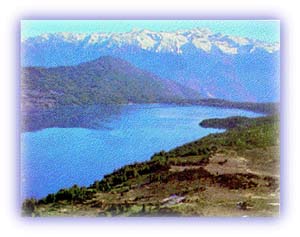Nepal Himalayas
General Info
· Solo Khumbu
· Namche Bazar
· Thyangboche
· Pangboche
· Kalapattar
· Pheriche
· Buddhism in Khumbu
· People: Sherpas
· Mount Everest
· The Quest for Everest
· Early Years
· The 1950s
· Sherpas on Everest
· Central Nepal
· Mustang
· Jomsom
· People: Thakalis
· Muktinath
· Manang valley
· Bryagu village
· Manang village
· Nyasang Division
· Western Nepal
Sukhadik
Photo Feature:
· Annapurna region
High Altitude Sickness
Endangered Species
Protected Areas
Yaks
The Yeti Factor

![]()
|
Jumla Jumla is the headquarters of the Karnali District. Compared with other areas, the development process in the region is slow and tourism is yet to pick up. The people in the region are Thakuris, a Chhetri sect that has the highest social, political and religious standing. Being conservative Hindus, they consider Westerners to be of low caste and thus unwelcome. Unlike other Nepalese, the Jumlaese are lethargic and inactive, backward in their thinking and economically poor. There is a vicious circle of poverty, inactivity and exploitation as the shopkeepers and other so-called higher castes exploit the poor. |
 |
| Rara Lake Credit: Mahabir Pun |
Sukhadik
Sukhadik is a large village in western Nepal towards the west
of the Rara National Park. It is located 600 ft above the
Karnali river on a flat plateau, where people are comparatively
better off and grow fruits like peaches, apricots, bananas and
also cultivate onions etc. They are gradually improving their
economy and live in slate roofed houses, indicating a better
living standard. The banana trees grow beside the little houses
of the villagers with thatched roofs and plenty of honey bee-
hives.
Just below Sukhadik, a rope bridge has been constructed over the swiftly flowing Karnali River at the cost of about 10 lakh Nepali Rupees. The iron rope cables were dropped by helicopters in the absence of motor roads, since heavy cables could not be transported manually by porters from Mahindra Nagar or Nepal Gunj even after a 15-20 days march. The difficulties of heavy construction in the interior of the Himalayas can be comprehended by such examples.
All rights reserved